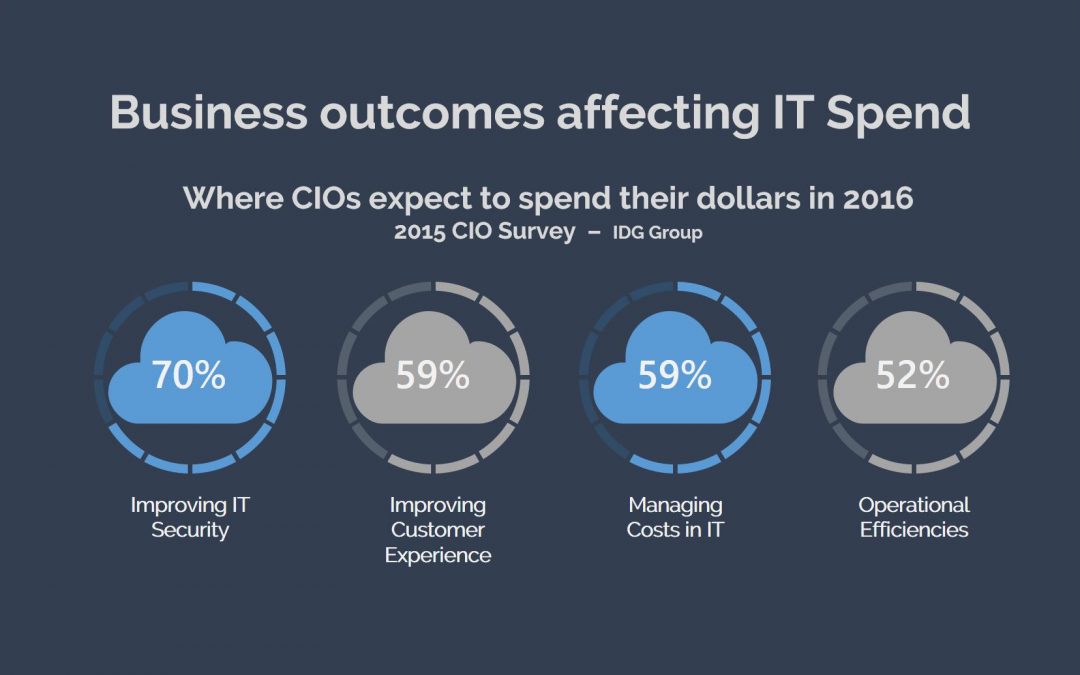How business outcomes are transforming IT spending
According to a recently released study by Datalink and IDG, business is playing a bigger role than ever in IT spending.
The relationship between business leaders and IT is equal parts necessary and contentious. More and more, though, decisions made on the business side are having an even greater impact on IT.
International Data Group IDG has just released the results of a study commissioned by Datalink, which showed just how closely linked IT investments are becoming with business results. The study polled more than 100 IT executives and senior level managers from large U.S. organisations and took place in Q4 2015.
When asked where they wanted to invest their IT dollars currently, respondents listed the following areas as their top five considerations:
- Improving of IT security – 70%
- Improving customer/client experiences – 59%
- Managing costs – 59%
- Boosting operational efficiency – 52%
- Mitigating risk – 44%
However, what may be more interesting is not where these organisations are making their investments in IT, but when. According to the report, 70% of respondents said it’s critical that they’re able to link IT investments to tangible business outcomes.
So, if an understanding of IT’s impact is this important, do these organisations feel that they are communicating that clearly enough? Well…not necessarily. Only 47% said that their organisations are doing an excellent or very good job at communicating how a particular IT investment impacted a business outcome. The remaining 53% said their organisation needs a least some, if not significant, improvement in doing so.
Not only did respondents say that identifying the impact on the business was important, but 68% of them said that, when making an IT investment decision, the business goals were more important than any of IT’s operational goals.
Since business is this important a consideration in each IT investment, let’s take a look at what the top running initiatives are, so far, among respondents. Here are the top five:
- Security
- Disaster recovery/business continuity
- IT governance/compliance management
- Cloud/virtualisation management
- Public cloud (including SaaS)
Of the projects currently in the build stage, the top three were agile development platforms, converged data center infrastructure, and process automation.
This, of course, begs the question of which IT initiatives are actually driving business outcomes. According to the report, process automation got top marks, and security, application performance management, and cloud/virtualisation management all got a nod as well. Although, all four of these were listed as the most difficult to deploy and maintain.
The IT lifecycle as a whole has its challenges, though. In building out an initiative, 41% said the planning stage was the most difficult, 36% claimed the building stage was the hardest, and 32% labeled testing the most challenging.
As businesses seek to tie in business success to IT investment, a few distinct roadblocks come up. Here is how respondents labeled the top five challenges in driving business outcomes through IT investments.
- Difficulty standardising/streamlining business processes – 34%
- Too many manual processes (need for more automation) – 33%
- Difficulty keeping up with demand for new application dev – 31%
- Poor communication between IT and lines of business – 29%
- Lack of support/sponsorship from executive management – 29%
Moving forward, as more of these leaders seek to connect the dots between their IT investments and how their business fares, most (56%) are looking to streamline the operational processes to make it more apparent. Others are increasing standardisation (38%) or moving away from legacy systems (37%) to accomplish the same.
Having spent a majority of my career working with and supporting the Corporate CIO Function, I now seek to provide a forum whereby CIOs or IT Directors can learn from the experience of others to address burning Change or Transformation challenges.

